Laphroaig
We have to thank Bessiefor this one
By Pip Hills who saw what water, barley, peat andthe ocean can produce.
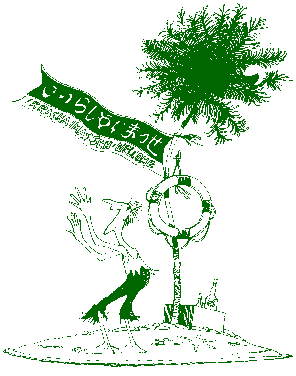 Reading Barnard immediately after avisit to Laphroaig distillery, one is struck by how much remainsas it was when the Baedeker of Scotch whisky visited it in 1886.The means may have been different - a ridiculously small aircraftof the elastic band variety, apparently held together by rivets,as opposed to Barnard's boat, and a bus where he had a horse andcart - but the end is much the same. The distillery is of veryold-fashioned type, lying in a hollow by a little bay. The beachwhere the puffers pulled up to unload coals is still suitable forsmall steamers, the pretty little burn still brawls through thepolicies and the view across the Sound of Jura to the Isle ofGigha and the Kintyre coast has changed not at all.
Reading Barnard immediately after avisit to Laphroaig distillery, one is struck by how much remainsas it was when the Baedeker of Scotch whisky visited it in 1886.The means may have been different - a ridiculously small aircraftof the elastic band variety, apparently held together by rivets,as opposed to Barnard's boat, and a bus where he had a horse andcart - but the end is much the same. The distillery is of veryold-fashioned type, lying in a hollow by a little bay. The beachwhere the puffers pulled up to unload coals is still suitable forsmall steamers, the pretty little burn still brawls through thepolicies and the view across the Sound of Jura to the Isle ofGigha and the Kintyre coast has changed not at all.
Perhaps the visitors have, somewhat. We had a contingent ofJapanese whose visit, it seems, was a reward for salesachievement. If ever I am to be marooned on a desert isle with abunch of salesmen, I sincerely hope it will be with Japanese.
Their natural courtesy and intelligence, as well as their goodhumour, would make it a pleasure. Having over the last year spenta fair bit of time in Japan and in Hebrides, I can see a fewreasons why there seems to be a natural affinity between theJapanese and the Scots. Besides a liking for whisky, there arestrong cultural affinities, standards of behaviour and systems ofbelief.
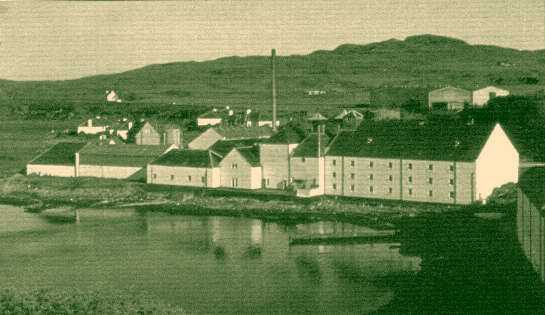 The Islay people, say Barnard, are veryhospitable. Then as now. Laphroaig is not one of those outfitswhich lie like litter on the whisky trail, traps for tourists,painted and neat so that busloads of geriatrics will commend themfor their tidiness. It is a working distillery and looks it,though clean enough for any granny. It doesn't turn tourists awaybut it does not cater for busloads of the terminally boredeither. If you want to see it, you must ring first and arrange tovisit - not a great disincentive. The return for such a smalleffort is disproportionately great, for there is a stronglikelihood that you will be shown round by the admirable IainHenderson himself, the distillery manager. He is a bigimprovement on the lassies in blazers and kilts that you get atthe showbiz end of the whisky business.
The Islay people, say Barnard, are veryhospitable. Then as now. Laphroaig is not one of those outfitswhich lie like litter on the whisky trail, traps for tourists,painted and neat so that busloads of geriatrics will commend themfor their tidiness. It is a working distillery and looks it,though clean enough for any granny. It doesn't turn tourists awaybut it does not cater for busloads of the terminally boredeither. If you want to see it, you must ring first and arrange tovisit - not a great disincentive. The return for such a smalleffort is disproportionately great, for there is a stronglikelihood that you will be shown round by the admirable IainHenderson himself, the distillery manager. He is a bigimprovement on the lassies in blazers and kilts that you get atthe showbiz end of the whisky business.
Iain describes how he first came to know Laphroaig. As a youngman in the 1950's - he is not so old now, so he must have beenvery young then - he was the engineer on a British merchant ship,sharing a piece of the Indian ocean with a hurricane. The crewhaving adopted drams as a prophylactic against irregular motion,whisky stocks ran out before the hurricane did, so crew wereforced back onto the chief steward's stock of Laphroaig. This,the product of some shady barter arrangement, lasted long enoughfor the young Henderson to acquire the taste.
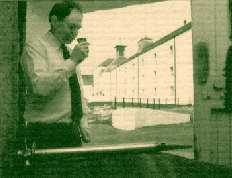 This story is told because there seemsto be some lesson in it. Quite what that is, is not immediatelyapparent, but it may become so as the Laphroaig goes down. Therecan be no doubt, it is an acquired taste. You either love it oryou hate it; few are indifferent. Even those who dislike thestuff will generally admit that there is a very fine whisky underthe peat reek.
This story is told because there seemsto be some lesson in it. Quite what that is, is not immediatelyapparent, but it may become so as the Laphroaig goes down. Therecan be no doubt, it is an acquired taste. You either love it oryou hate it; few are indifferent. Even those who dislike thestuff will generally admit that there is a very fine whisky underthe peat reek.
The latter is the main reason for the very distinctive noseand taste. The distillery malts a large part of its own barleyand on almost any working day, the distillery can be found bynose alone, if you happen to be downwind. It has a propermalthouse with several floors where the barley is malted in thetraditional manner and a kiln where it is dried. The kiln hasproper pagoda roofs and altogether the whole thing looks andsmells as it ought. The malt, once dried, is sweet, crisp andincredibly smoky.
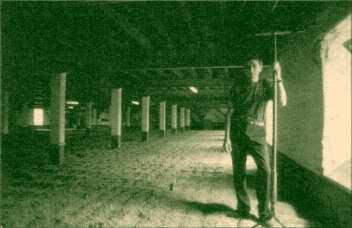 There is a widespread belief that thepeculiar flavour of Islay malts is caused by their littorallocation, hence descriptions of them as being seaweedy and fullof iodine. While the influence of the sea cannot be discountedentirely, it must be negligible by comparison with the effect ofthe peatsmoke from the malt kiln. Certainly, when Barnard askedthe then distillery owner, the latter was quite clear that it wasthe peat that mattered. It would be interesting to see a highlandwhisky made from heavily-peated malt. The nearest we have isprobably Clynelish, which could easily be mistaken for an Islay,for it has a more peaty nose than some of the Islays, such asBunnahabhain or Bruichladdich, which use lightly-peated malt.
There is a widespread belief that thepeculiar flavour of Islay malts is caused by their littorallocation, hence descriptions of them as being seaweedy and fullof iodine. While the influence of the sea cannot be discountedentirely, it must be negligible by comparison with the effect ofthe peatsmoke from the malt kiln. Certainly, when Barnard askedthe then distillery owner, the latter was quite clear that it wasthe peat that mattered. It would be interesting to see a highlandwhisky made from heavily-peated malt. The nearest we have isprobably Clynelish, which could easily be mistaken for an Islay,for it has a more peaty nose than some of the Islays, such asBunnahabhain or Bruichladdich, which use lightly-peated malt.
Besides the malthouse at Laphroaig, the distillery has theusual complement of mashtuns, washback, stills, etcetera. Thereare six stills, of the swanneck variety. The process of shiftingspirit from one still to another is a complex one, requiring finejudgment on the part of the stillman. Iain explained that thoughthis, like much of the rest of the distillery, is fairlyold-fashioned, the owners see no reason to change it, on the verygood ground that since the present kit makes some of the bestliquor on the planet, change is unlikely to be for the better.
 The distillery guards its water supplymost carefully. It owns all of the land from which flows the burnwhich supplies the mashtuns. There are no cows or sheep on themoor, or any human intrusion, so that the distiller may be surethat all of the influences on the water supply are as natural aspossible. It appears that the greatest care has been taken of thequality of the materials from a very early date.
The distillery guards its water supplymost carefully. It owns all of the land from which flows the burnwhich supplies the mashtuns. There are no cows or sheep on themoor, or any human intrusion, so that the distiller may be surethat all of the influences on the water supply are as natural aspossible. It appears that the greatest care has been taken of thequality of the materials from a very early date.
The distillery had for many years the distinction of being theonly Scotch malt distillery owned and run by a woman. BessieWilliamson joined the company in the 1930's as a chemist. Sherapidly came to take control of the production process and in theearly 1950's became owner. She continued to run the business andthe distillery until the 1960's. Her expertise in and love forher product is sufficient evidence, if any were needed, of thefalsity of the macho image of Scotch whisky in general and Islaysin particular.
The Laphroaig is matured at the distillery in American bourboncasks. In the warehouse, the Kentucky origins are sometimesevident on the cask ends, which bear stencils of Jim Beam andJack Daniels. The proprietary bottlings of Laphroaig are at tenand fifteen years old, all from bourbon casks.
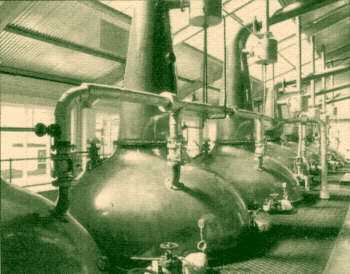 Laphroaig is the market leader for Islaymalts, and may take most of the credit for the prominence ofwhiskies from that island in world markets. Annual sales are anastonishing 80,000 cases of the stuff, which just to show that ifyou have a taste for tar, you are not alone.
Laphroaig is the market leader for Islaymalts, and may take most of the credit for the prominence ofwhiskies from that island in world markets. Annual sales are anastonishing 80,000 cases of the stuff, which just to show that ifyou have a taste for tar, you are not alone.
There are two proprietary bottlings: a ten year old and afifteen year old. Both are excellent, though it was the opinionto the Committee that the spirit benefited from the additionalfive years' maturation, the older whisky undoubtedly being thebetter of the two. The comparison of ten year old, fifteen yearold and Society bottlings (of 18 year old) is instructive.Laphroaig use only bourbon casks for maturing their spirit. Thereare sherry butts in the warehouse, but these belong to customerswho require such maturation for their blends. The bourbon is allin American white oak. There is some variation among casks, butas far as we could see, not a lot. The result is a prettyconsistent maturation, from which the effect of age isparticularly apparent.
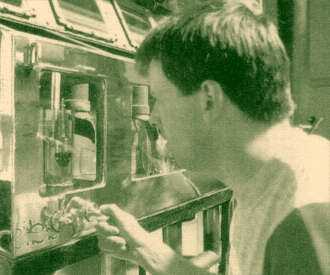 As most members should know, age in caskbeyond about ten years is not necessarily a good thing in a malt,though many casks do continue to improve beyond that point. Inthe case of Laphroaig and its bourbon casks, the process appearsto be fairly consistent, with the older whiskies being the moreappealing in some ways, less in others. We realise thatstatistically this is a small sample and hence generalisationsmay be invalid. However, the consistent quality of the caskswhich we inspected gives us confidence in the generalproposition. Having said that, we are all agreed that thecombination of bourbon wood with heavily-peated malt is a mostfelicitous one.
As most members should know, age in caskbeyond about ten years is not necessarily a good thing in a malt,though many casks do continue to improve beyond that point. Inthe case of Laphroaig and its bourbon casks, the process appearsto be fairly consistent, with the older whiskies being the moreappealing in some ways, less in others. We realise thatstatistically this is a small sample and hence generalisationsmay be invalid. However, the consistent quality of the caskswhich we inspected gives us confidence in the generalproposition. Having said that, we are all agreed that thecombination of bourbon wood with heavily-peated malt is a mostfelicitous one.
If you have comments about thissite, please contact the webmaster. Unless otherwise noted, all information in this siteŠ The Scotch Malt Whisky Society, Edinburgh, Scotland, 1997.
 Reading Barnard immediately after avisit to Laphroaig distillery, one is struck by how much remainsas it was when the Baedeker of Scotch whisky visited it in 1886.The means may have been different - a ridiculously small aircraftof the elastic band variety, apparently held together by rivets,as opposed to Barnard's boat, and a bus where he had a horse andcart - but the end is much the same. The distillery is of veryold-fashioned type, lying in a hollow by a little bay. The beachwhere the puffers pulled up to unload coals is still suitable forsmall steamers, the pretty little burn still brawls through thepolicies and the view across the Sound of Jura to the Isle ofGigha and the Kintyre coast has changed not at all.
Reading Barnard immediately after avisit to Laphroaig distillery, one is struck by how much remainsas it was when the Baedeker of Scotch whisky visited it in 1886.The means may have been different - a ridiculously small aircraftof the elastic band variety, apparently held together by rivets,as opposed to Barnard's boat, and a bus where he had a horse andcart - but the end is much the same. The distillery is of veryold-fashioned type, lying in a hollow by a little bay. The beachwhere the puffers pulled up to unload coals is still suitable forsmall steamers, the pretty little burn still brawls through thepolicies and the view across the Sound of Jura to the Isle ofGigha and the Kintyre coast has changed not at all. The Islay people, say Barnard, are veryhospitable. Then as now. Laphroaig is not one of those outfitswhich lie like litter on the whisky trail, traps for tourists,painted and neat so that busloads of geriatrics will commend themfor their tidiness. It is a working distillery and looks it,though clean enough for any granny. It doesn't turn tourists awaybut it does not cater for busloads of the terminally boredeither. If you want to see it, you must ring first and arrange tovisit - not a great disincentive. The return for such a smalleffort is disproportionately great, for there is a stronglikelihood that you will be shown round by the admirable IainHenderson himself, the distillery manager. He is a bigimprovement on the lassies in blazers and kilts that you get atthe showbiz end of the whisky business.
The Islay people, say Barnard, are veryhospitable. Then as now. Laphroaig is not one of those outfitswhich lie like litter on the whisky trail, traps for tourists,painted and neat so that busloads of geriatrics will commend themfor their tidiness. It is a working distillery and looks it,though clean enough for any granny. It doesn't turn tourists awaybut it does not cater for busloads of the terminally boredeither. If you want to see it, you must ring first and arrange tovisit - not a great disincentive. The return for such a smalleffort is disproportionately great, for there is a stronglikelihood that you will be shown round by the admirable IainHenderson himself, the distillery manager. He is a bigimprovement on the lassies in blazers and kilts that you get atthe showbiz end of the whisky business. This story is told because there seemsto be some lesson in it. Quite what that is, is not immediatelyapparent, but it may become so as the Laphroaig goes down. Therecan be no doubt, it is an acquired taste. You either love it oryou hate it; few are indifferent. Even those who dislike thestuff will generally admit that there is a very fine whisky underthe peat reek.
This story is told because there seemsto be some lesson in it. Quite what that is, is not immediatelyapparent, but it may become so as the Laphroaig goes down. Therecan be no doubt, it is an acquired taste. You either love it oryou hate it; few are indifferent. Even those who dislike thestuff will generally admit that there is a very fine whisky underthe peat reek. There is a widespread belief that thepeculiar flavour of Islay malts is caused by their littorallocation, hence descriptions of them as being seaweedy and fullof iodine. While the influence of the sea cannot be discountedentirely, it must be negligible by comparison with the effect ofthe peatsmoke from the malt kiln. Certainly, when Barnard askedthe then distillery owner, the latter was quite clear that it wasthe peat that mattered. It would be interesting to see a highlandwhisky made from heavily-peated malt. The nearest we have isprobably Clynelish, which could easily be mistaken for an Islay,for it has a more peaty nose than some of the Islays, such asBunnahabhain or Bruichladdich, which use lightly-peated malt.
There is a widespread belief that thepeculiar flavour of Islay malts is caused by their littorallocation, hence descriptions of them as being seaweedy and fullof iodine. While the influence of the sea cannot be discountedentirely, it must be negligible by comparison with the effect ofthe peatsmoke from the malt kiln. Certainly, when Barnard askedthe then distillery owner, the latter was quite clear that it wasthe peat that mattered. It would be interesting to see a highlandwhisky made from heavily-peated malt. The nearest we have isprobably Clynelish, which could easily be mistaken for an Islay,for it has a more peaty nose than some of the Islays, such asBunnahabhain or Bruichladdich, which use lightly-peated malt. The distillery guards its water supplymost carefully. It owns all of the land from which flows the burnwhich supplies the mashtuns. There are no cows or sheep on themoor, or any human intrusion, so that the distiller may be surethat all of the influences on the water supply are as natural aspossible. It appears that the greatest care has been taken of thequality of the materials from a very early date.
The distillery guards its water supplymost carefully. It owns all of the land from which flows the burnwhich supplies the mashtuns. There are no cows or sheep on themoor, or any human intrusion, so that the distiller may be surethat all of the influences on the water supply are as natural aspossible. It appears that the greatest care has been taken of thequality of the materials from a very early date. Laphroaig is the market leader for Islaymalts, and may take most of the credit for the prominence ofwhiskies from that island in world markets. Annual sales are anastonishing 80,000 cases of the stuff, which just to show that ifyou have a taste for tar, you are not alone.
Laphroaig is the market leader for Islaymalts, and may take most of the credit for the prominence ofwhiskies from that island in world markets. Annual sales are anastonishing 80,000 cases of the stuff, which just to show that ifyou have a taste for tar, you are not alone. As most members should know, age in caskbeyond about ten years is not necessarily a good thing in a malt,though many casks do continue to improve beyond that point. Inthe case of Laphroaig and its bourbon casks, the process appearsto be fairly consistent, with the older whiskies being the moreappealing in some ways, less in others. We realise thatstatistically this is a small sample and hence generalisationsmay be invalid. However, the consistent quality of the caskswhich we inspected gives us confidence in the generalproposition. Having said that, we are all agreed that thecombination of bourbon wood with heavily-peated malt is a mostfelicitous one.
As most members should know, age in caskbeyond about ten years is not necessarily a good thing in a malt,though many casks do continue to improve beyond that point. Inthe case of Laphroaig and its bourbon casks, the process appearsto be fairly consistent, with the older whiskies being the moreappealing in some ways, less in others. We realise thatstatistically this is a small sample and hence generalisationsmay be invalid. However, the consistent quality of the caskswhich we inspected gives us confidence in the generalproposition. Having said that, we are all agreed that thecombination of bourbon wood with heavily-peated malt is a mostfelicitous one.